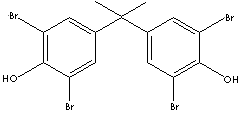TETRABROMOBISPHENOL A
PRODUCT IDENTIFICATION
79-94-7

201.236.9
H.S. CODE
UN NO.
TOXICITY
CLASSIFICATION
Brominated flame retardant, Bisphenol Monomer.
PHYSICAL AND CHEMICAL PROPERTIES
MELTING POINT
SOLUBILITY IN WATER
SOLVENT SOLUBILITY
Acetone 69.60; Methanol 47.20; Toluene 6.40; Styrene 8.50
AUTOIGNITION
NFPA RATINGS
REFRACTIVE INDEX
178 C
EXTERNAL LINKS & GENERAL DESCRIPTION
http://www.nicnas.gov.au/
SUMMARY
REPORT FOR POLYBROMINATED FLAME RETARDANTS
GENERAL DESCRIPTION: Tetrabromobisphenol A (TBBPA) has the largest market among brominated flame retardants. It is a white to off-white powder melting point of 180-184°C; soluble in methanol and ether. TBBPA is produced by the bromination of BPA (bisphenol A) with various solvents such as halocarbon alone, hydrobromic acid, aqueous alkyl monoethers, acetic acid ( with sodium acetate to improve colouror) or methanol (methyl bromide is expected as a co-product). Tetrabromobisphenol A (TBBPA) is used as a reactive flame retardant in epoxy, vinyl esters and polycarbonate resins. The main application of TBBPA in epoxy resins is in PCB (printed circuit boards) where the bromine content may be 20% by weight. It is used also as a flame retardant in polymers such as ABS, polystyrenes, phenolic resins, adhesives, paper, and textiles and others. TBBPA can be combined with a synergist such as antimony trioxide for maximum flame retardant performance. TBBPA may also be used as a parent compound for the production of other commercial flame retardants, such as tetrabromobisphenol A bis(2-hydroxyethyl ether), tetrabromobisphenol A dibromopropylether, tetrabromobisphenol A bis(allylether), tetrabromobisphenol A carbonate oligomers, and tetrabromobisphenol A brominated epoxy oligomer.
APPEARANCE
PURITY (GLC)
99.5% min
BROMINE CONTENT
58.0% min
MELTING POINT
179 - 182 C
VOLATILES
0.1% max
Not regulated
Flame Retardant is a substance that can be chemically inserted into the polymer molecule or be physically blended in polymers after polymerization to suppress, reduce, delay or modify the propagation of a flame through a plastic materials. There are several classes of flame retardants; Halogenated Hydrocarbons (Chlorine and Bromine containing compounds and reactive flame retardants), Inorganic flame retardants ( Boron compounds, Antimony oxides, Aluminium Hydroxide, molybdenum compounds, zinc and magnesium oxides ), Phosphorous containing compounds (Organic phosphate esters, phosphates, halogenated phosphorus compounds and inorganic phosphorus containing salts).
Class of Flame Retardants
- Inorganic
- Metal hydroxides
- Aluminium hydroxide
- Magnesium hydroxide
- Orthers
- Antimony compounds
- Antimony trioxide
- antimony pentoxide
- Sodium antimonate
- Others
- Boron compounds
- Boric acid
- Borax
- Zinc borate
- Others
- Other metal compounds
- Molybdenum compounds
- Titanium compounds
- Zirconium compounds
- Zinc compounds
- Zinc stannate
- Zinc hydroxy-stannate
- Others
- Others
- Phosphorus compounds
- Red phosphorus
- Ammonium polyphosphate
- Others
- Other inorganic flame retardants
- ammonium sulfamate
- ammonium bromide
- Others
- Halogenated organic
- Brominated
- Tetrabromobisphenol A
- Decabromodiphenyl ether
- Octabromobiphenyl ether
- Tetrabromobiphenyl ether
- Hexabromocyclododecane
- Tribromophenol
- Bis(tribromophenoxy) ethane
- Tetrabromobisphenol A polycarbonate oligomers
- Tetrabromobisphenol A epoxy oligomers
- Others
- Chlorinated
- Chlorinated paraffins
- Bis(hexachlorocyclopentadieno)cyclo-octane
- Others
- Organophosphoros
- Non-halogenated compounds
- phosphate esters
- Ttrialkyl phosphates
- Triaryl phosphates
- Aryl-alkyl phosphates
- Others
- polyols
- phosphonium derivatives
- phosphonates
- Others
- Halogenated phosphates
- Tris(1-chloro- 2-propyl) phosphate
- Tris(2-chloroethyl) phosphate
- Tris(2,3-dibromopropyl)phosphate
- Others
- Nitrogen-based
- Polyurethanes
- Polyamides
- Melamine and its salts
- Guanidine compounds
- Others